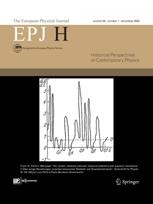Revisiting Clebsch’s early papers
New analysis of two recently translated papers, first published in the 1850s, assesses the early methods used by Alfred Clebsch to describe the flow of incompressible fluids, and explores their impact on active areas of cutting-edge research
New York | Heidelberg, 6 August 2021
 Alfred Clebsch is widely considered to be one of the fathers of algebraic geometry. Born in Prussia in 1833, he completed his PhD at just 21, and went on to publish two important papers soon afterwards, in 1857 and 1859. In these studies, he introduced mathematical constructs that are now called ‘Clebsch variables,’ which describe the velocity field of a fluid, and which are widely cited. Now, a team of researchers in France, Germany, the US and Brazil present the first English translations of Clebsch’s two early papers after more than 160 years. In an accompanying study published in EPJ H, important new explanations are provided for the difficult language of the papers.
Alfred Clebsch is widely considered to be one of the fathers of algebraic geometry. Born in Prussia in 1833, he completed his PhD at just 21, and went on to publish two important papers soon afterwards, in 1857 and 1859. In these studies, he introduced mathematical constructs that are now called ‘Clebsch variables,’ which describe the velocity field of a fluid, and which are widely cited. Now, a team of researchers in France, Germany, the US and Brazil present the first English translations of Clebsch’s two early papers after more than 160 years. In an accompanying study published in EPJ H, important new explanations are provided for the difficult language of the papers.
When translating any scientific work, it is often difficult to decide whether the author’s original language should be recreated as faithfully as possible, or whether the translation should be made as accessible as possible to readers in the new language. This challenge was especially pronounced in the case of Clebsch’s two early papers: his 1857 paper was twice as long as the 1859 study, and extremely difficult to understand. With expert guidance from Wolf Beiglböck of Heidelberg University, founder and former chief editor of EPJ H, these challenges have now been addressed by Uriel Frisch at the Côte d'Azur Observatory in Nice; David Delphenich, an independent researcher in Spring Valley, Ohio; and Gérard Grimberg at the Federal University of Rio de Janeiro.
The comments on the translations were written by Gérard Grimberg and Emanuele Tassi at the Côte d'Azur Observatory, after consultation with Uriel Frisch. On the one hand, it was essential for the authors of the translations to understand Clebsch’s exceptionally novel goals. These included N-dimensional formulations, which he used long before the mathematics of N-dimensional vector spaces were introduced; as well as a variational formulation similar to those used in modern research.
On the other hand, it was crucial for the authors to understand the historical context of Clebsch’s work. In fact, this started in the first half of the nineteenth century with the work of the German mathematician Carl Jacobi, which had a great influence on the early phase of Clebsch’s scientific activity. Through his calculations, Jacobi made vital contributions to the mathematics of differential equations – which relate functions representing physical quantities to their rate of change.
It is important to realize that the hydrodynamical work of Clebsch is only starting to become well-known outside of Germany. In Clebsch’s time, other German scientists such as Hermann von Helmholtz were far more well known in Britain, and so his work was never prioritised for translation into English at the time. A renewed interest emerged over a century later in the 1960s, where several studies connected his mathematics with the latest theories of fluid dynamics, electromagnetism, and magnetohydrodynamics – which studies the magnetic behaviours of electrically conducting fluids.
Since the 1980s, countless related studies have based their mathematical techniques on the variables first introduced by Clebsch. These two translations and the comments now provide fresh new insights into work which continues to influence many ongoing areas of research relating to fluid dynamics. Altogether, the team’s efforts culminated in four years of work, making it a substantial project in the 11-year history of EPJ H. The results of their work provide a modern perspective on Clebsch’s early papers, which despite their clear relevance to modern fluid dynamics research, have been widely overlooked so far.
References:
[1] Grimberg, G., Tassi, E. Comment on Clebsch’s 1857 and 1859 papers on using Hamiltonian methods in hydrodynamics. EPJ H 46, 17 (2021). https://doi.org/10.1140/epjh/s13129-021-00014-9
[2] Clebsch, A. On a general transformation of the hydrodynamical equations. EPJ H 46, 18 (2021). https://doi.org/10.1140/epjh/s13129-021-00015-8
[3] Clebsch, A. On the integration of the hydrodynamical equations. EPJ H 46, 19 (2021). https://doi.org/10.1140/epjh/s13129-021-00016-7
Further Information
For more information visit: www.epj.org
Contact
Sabine Lehr | Springer | Physics Editorial Department
tel +49-6221-487-8336 | sabine.lehr@springer.com
